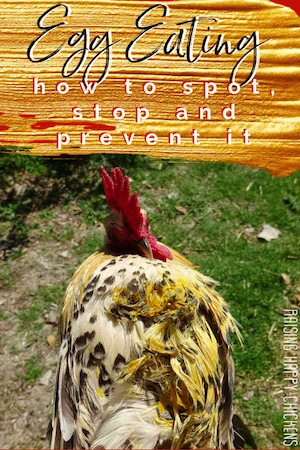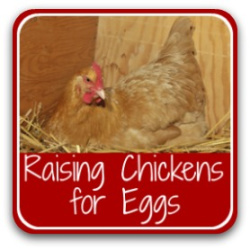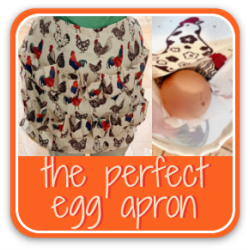- Home
- Challenges
- Egg eating
Can chickens eat eggs?
They can, but only in certain circumstances. In others, it's a bad habit which is almost impossible to break.
Of course, chickens can eat eggs. Full of natural goodness, they can add protein to the diet at times of stress, and help an ailing chicken recover.
They're also immensely good for weak baby chicks.
But chickens must only be given eggs which are cooked. Eating raw eggs is a habit which is incredibly difficult to break – and once one flock member starts, the rest will follow.
Suddenly you have no more eggs for your family to eat. No more to gift to your neighbours. No more to sell, if that's what you do.
It can happen that quickly.
This article looks at how to tell you have an egg-eating problem in your flock, why it happens, what you can do to prevent it, and what you can do if it’s already an issue.
Has it already happened to you? Never fear – there are ways of dealing with it.
This is a long, detailed article. It's all important to make sure this problem doesn't become a big deal in your coop.
However, if there's one issue you want to learn more about first, click any of these links to jump to that section.
How to tell you have an egg eating problem.
It's easy to tell. One day you have a full clutch of eggs, the next you either have no eggs, or several eggs with holes in them.
Another sure sign is chickens wandering about with tell-tale egg yolk around the face or breast area.
This reprobate is Bono, my little lemon Milllefleur Sablepoot rooster. Cute, isn't he?
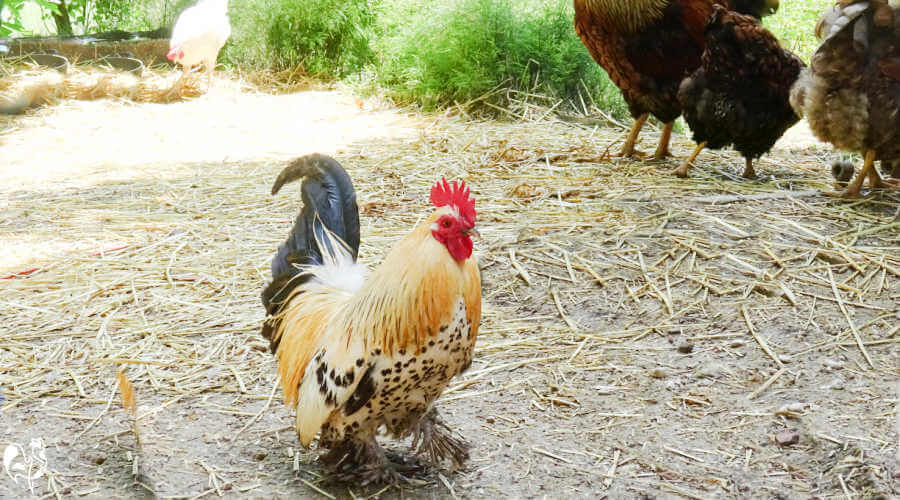
Except that Bono found an egg which was probably broken by accident, and decided he liked the taste so much that he would choose to answer the question "can chickens eat eggs" by having a couple for breakfast each morning.
It was a few days before I discovered who the culprit was – he was good at covering his tracks. Until he got overconfident and gorged on three or four at the same time.
All of which left their mark...
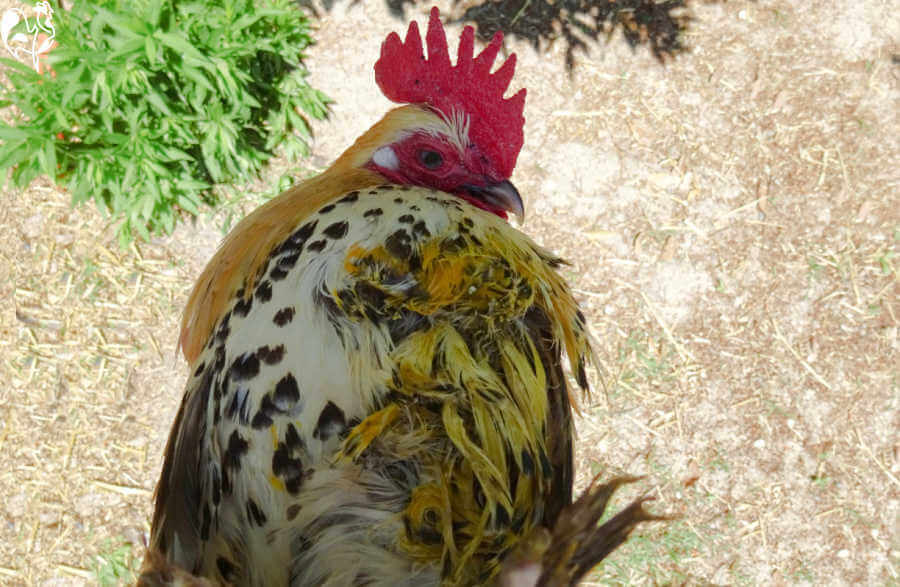 Bono, my lemon Millefleur Sablepoot, developed a liking for raw eggs which he was unable to disguise.
Bono, my lemon Millefleur Sablepoot, developed a liking for raw eggs which he was unable to disguise.How to stop egg eating, step 1.
So, if you have disappearing or pecked eggs, your first step is to identify the culprit. It may not be as obvious as it was with Bono. If you have heavily feathered breeds such as Orpingtons, you'll need to examine them more closely.
We will look at what to do with him/her later.
How to tell if the culprit is not a chicken.
If you don't see any obvious signs of egg eating on any of your flock's feathers, it may be time to consider whether the culprit is not a chicken after all. Because it's not only chickens who can eat eggs.
This egg was not a Bono victim. It was eaten before he joined the flock, and I had never had any issues with chickens eating their own eggs before that.
The culprit this time was a rat. Yes – rats do eat eggs, if they get the chance…
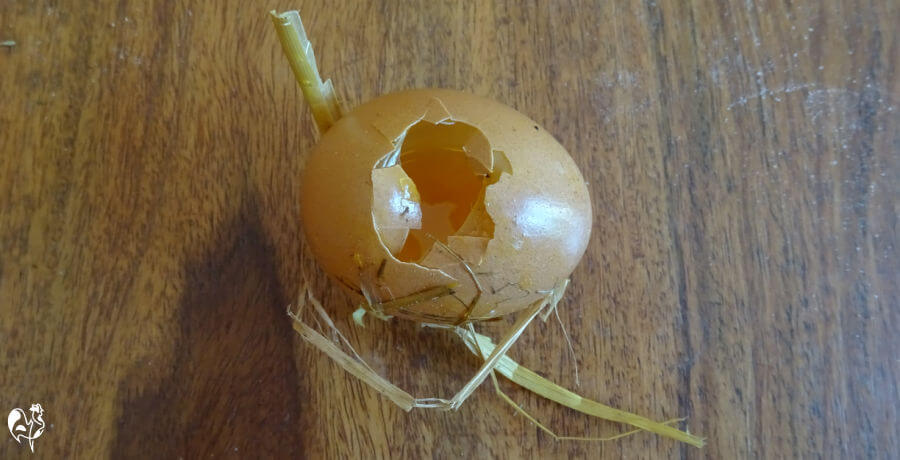 One of my chicken eggs – this was not an egg eating chicken, but a rat.
One of my chicken eggs – this was not an egg eating chicken, but a rat.How to tell whether it's a chicken or something else? It's not always easy, but generally speaking chickens will leave more of a mess.
Other creatures tend to clear the egg completely, and some (snakes for example) will eat the whole thing, including the shell.
How to stop egg eating, step 2.
A number of creatures love nothing more than chomping on a fresh egg. Rats, weasels, snakes, raccoons, squirrels, wild birds (especially crows) are potential offenders.
This page will help you assess whether you have a rat problem and what to do about it, and here you'll find articles relating to identifying other predators who may also be guilty.
And sometimes you'll know because you catch the felon red-handed.
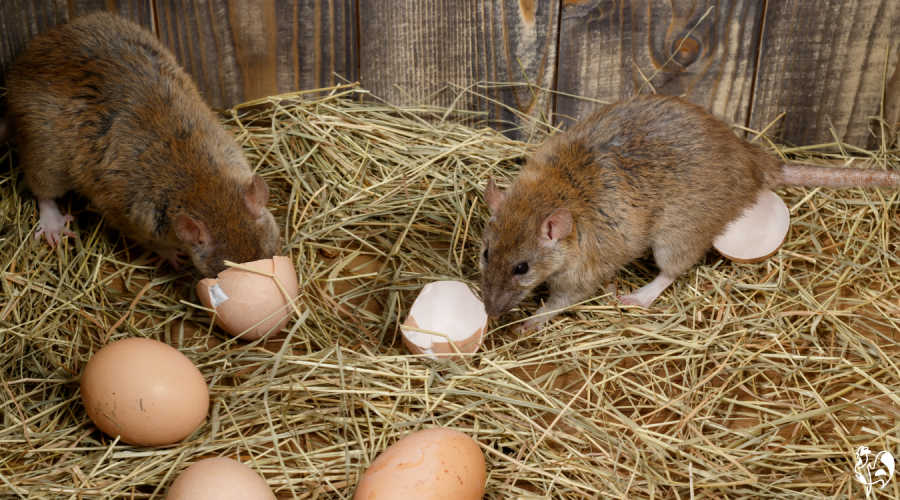 Rats enjoy feasting on raw eggs – it's an easy meal.
Rats enjoy feasting on raw eggs – it's an easy meal.Deal with that problem and you may discover that your egg eating issues are a thing of the past.
Why do chickens eat chicken eggs?
(Or any other kind of egg, for that matter).
Examining the causes of egg eating within a flock can give us the answers to preventing it. Research(e.g. 1, 2, 3) has consistently shown that the causes are often to do with poor husbandry, often a result of lack of knowledge rather than neglect.
Once steps have been taken to manage welfare practices, egg eating should stop.
The most common reasons why chickens can start eating eggs are as follows – click on the links if you're interested in a particular subject:
- Eggs sitting in nest boxes for too long
- Insufficient space in nest boxes
- Poor choice of nest box material
- Poor diet
- Calcium deficiency
- Insufficient access to water
- Boredom
- Allowing an existing egg eating problem to continue (curing).
Let's look at each of those areas in turn. The rest of this article outlines simple, practical steps you can take to make sure your environment is safe, healthy and an antidote to chickens eating eggs.
Links on the rest of this page are "affiliate links". If you click on them and buy, I earn a small commission at no cost to you. I only recommend products I know and love and which I think will be genuinely useful to you. See my disclosure policy for more information.
How to prevent chickens eating eggs.
It's much easier to prevent chickens from eating their own eggs than to cure it once you have a problem.
If you don't yet have egg eating in your flock, these steps, based on why chickens eat eggs, will help you prevent it. If you do have an egg eating chicken, start by looking a how to deal with the issue, and at the same time start to put these steps into practice straight away.
How often should you collect chicken eggs?
This one is straightforward and comes first because it's something you can do straight away.
It's one of the simplest and most effective ways of breaking the egg eating habit: if there are no eggs left in the coop, chickens cannot eat them.
Hens notoriously favour one or two nest boxes, no matter how many they have on offer. A crowded nest box (I've seen three of my hens squeeze into one!) is much more likely to be a source of broken eggs.
Step 3: collect eggs early and often.
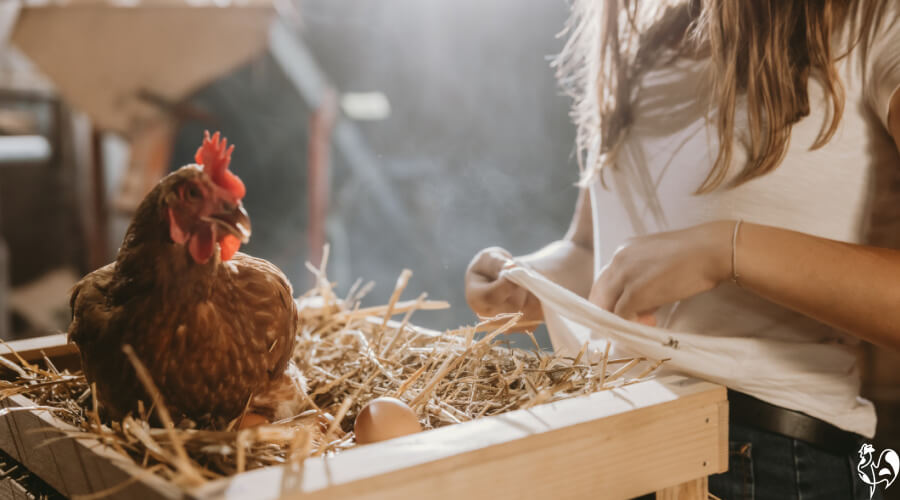 Children (and grandchildren) enjoy helping to collect eggs!
Children (and grandchildren) enjoy helping to collect eggs!Checking nest boxes every 30 minutes at the time your hens usually lay not only removes the temptation, it is also much less likely that the eggs will break.
If you're not able to do it personally, task a family member or neighbour. Offering a "thank you" gift of some fresh eggs can work wonders.
And providing a pretty basket (this one is lighter than wicker, and excellent for kids collecting just a few eggs), or a cute egg collecting apron can also be a great incentive!
What if you can't collect eggs regularly?
Commercial egg producers cannot afford to allow egg eating. They prevent it by having the egg rolled away from under the chicken as soon as it is laid.
Of course, commercial farms tend not to worry much about the welfare of the birds, so caged hens do not have bedding material, which makes egg rolling much easier.
However, there are ways of providing rollaway nest boxes at home, while making sure that your chickens' welfare is still top priority.
Step 4: consider rollaway nest boxes.
See this page for more detailed information about how rollaway nest boxes work and where to find them.
Interested in making your own? Take a look at this video – it's fascinating to watch, even if you don't intend to DIY!
Why nest boxes are important in preventing egg eating.
One of the five welfare requirements for chickens is that they have enough space to lay their eggs in a secure, safe environment(1, 2, 3). If they don't, as well as being likely to lay in places well hidden from your sight, behaviour problems including egg pecking are likely to follow.
So it's important that your nest boxes provide as much safety as your hens need.
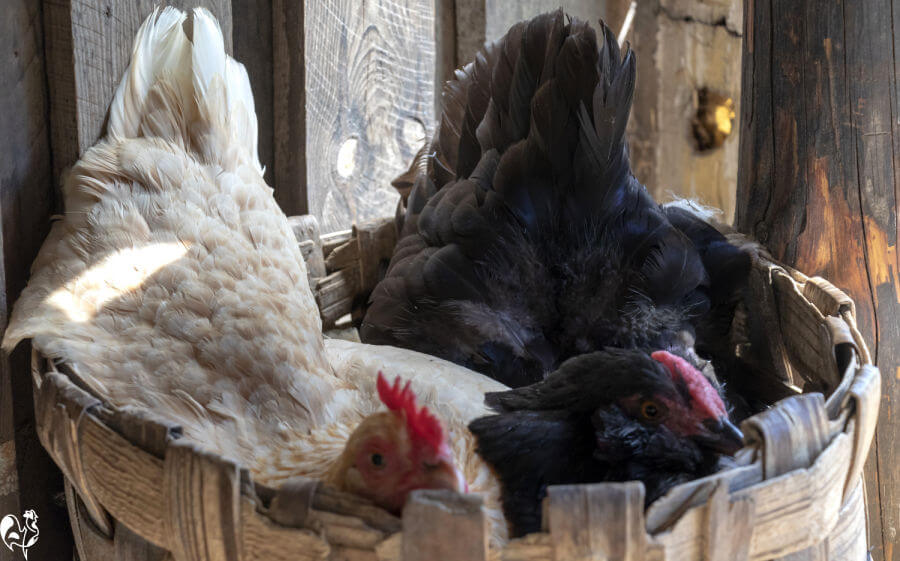
Step 5: make sure your nest boxes are fit for purpose.
Nest boxes should be:
- at a ratio of one nest box for every five hens (I prefer a ratio of one to 3)
- large enough for the hen to be able to sit, stand and turn around
- in a location safe from disturbance by other animals or people
- raised slightly off the ground but still accessible, particularly by breeds unable to fly
- placed in a quiet, dimly lit area. If lighting is an issue, provide a cover (like curtains) at the front of the nest box.
For much more detailed information about what makes a good nest box design, take a look at this article. It will open in a new page so that you do not lose your place here.
Nest box bedding.
Eggs are easily broken through having inadequate bedding in nest boxes, and an already broken egg is a sure way to start a habit of eating.
Whichever lining you use in nest boxes, it's critically important that it remains clean, dry and free from poop. Hens will not lay lay in a dirty nest box!
Step 6: use the right kind of bedding in the nest box.
- Straw is most commonly used. It's soft and inexpensive, but can be problematic in terms of harbouring damp and mites.
- Commercially produced nest liners are available (some are even infused with herbs!). There is soft enough for eggs not to break, and are washable and recyclable. These are now my preferred option.
- Sand has become a popular option; it should be builders' grade, not play sand.
- Large wood shavings are an option. Make sure they are not chemically treated and avoid cedar. Untreated pine shavings are best.
This article has very detailed information about both the location of nest boxes and the pros and cons of different types of bedding material.
If you're serious about ensuring your hens have the best, it's an excellent place to start.
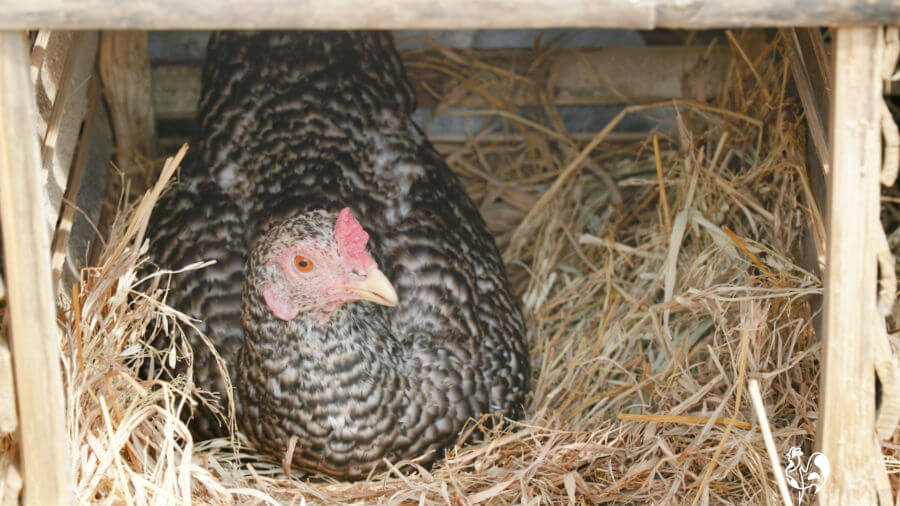 Clean straw makes a soft bedding to catch eggs.
Clean straw makes a soft bedding to catch eggs.Why diet is important, and what to do about it.
If your chickens are eating their eggs, it may mean they are lacking nutritionally in their usual diet.
Making and laying eggs requires a high level of good quality protein. Eggs contain between 6% and 13% protein, depending on the size of egg and the hen's diet.
So a hen who is not getting enough protein in her chicken feed will try to find it elsewhere – including from her own eggs.
Step 7: assess your flock's diet.
- Check the feed you're using. For laying hens from about 18 weeks old it should be between 16% and 18% protein.
- Consider fermenting your chicken feed. It's a simple process, and makes the vitamins and minerals in the feed more easily absorbed. It also creates an environment in which bacteria cannot thrive.
- For more information about the benefits of fermenting feed, see this page.
- At times of stress such as moulting or after a predator attack, chickens need more protein. Adding protein rich treats to their diet can help. Avoid using these too regularly since they can lead to obesity.
- Bear in mind that plants, weeds, sprouts and herbs can also be a good source of high-level nutrients, without adding additional fat to the diet.
For more detailed information about the feed chickens need at different times of the life, see this page.
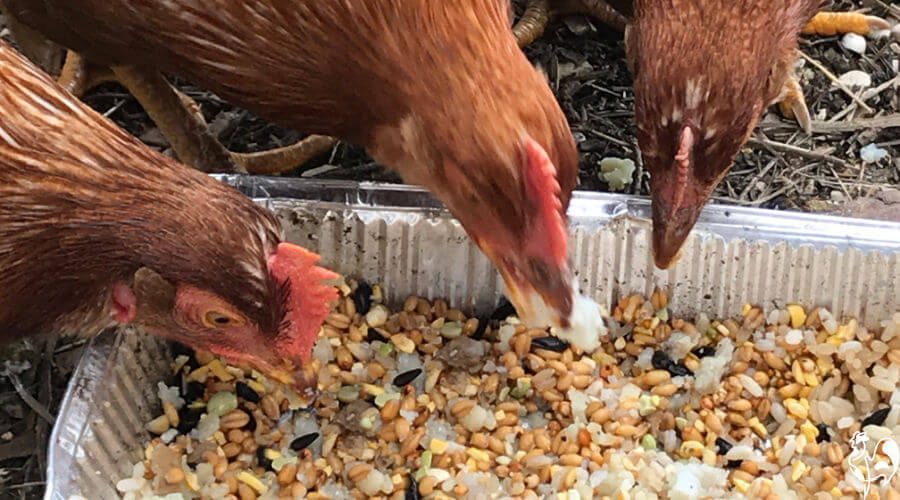 My Red Stars love fermented feed, which makes high quality eggshells.
My Red Stars love fermented feed, which makes high quality eggshells.Why calcium is important.
Egg shells are made almost entirely (95%) of calcium carbonate. Making an egg shell – sometimes as many as one per day – takes a lot of calcium.
If a hen isn't getting enough, her own bones will be used as the calcium source, resulting in brittle bones and the probability of breakages.
And a diet low in calcium will result in thin shells which break more easily. It can even be the cause of eggs laid with a very soft, or no, shell which creates issues like the hen becoming egg-bound, a condition which is often fatal.
Poor quality shells are much more likely to break in the nest. And a broken egg is, as we know, one of the main causes of egg eating.
Make sure yours are as strong as possible.
Step 8: give your hens enough calcium.
- Even if your feed has calcium, offer your flock an additional source which is available to them all the time. Hens will take what they need, and males will avoid it. Instinct is a wonderful thing.
- The easiest and most efficient way is to buy a ready made source like oyster shell. Do not mix it in with their feed. Put it in a separate container.
- Some people choose to use the hens' own shells, properly cleaned and broken into tiny bits.
- Be careful with this though. If your hens are not getting enough calcium in the first place, their eggs will not have the amount they need. It can be a vicious circle.
For more detailed information about the difference between oyster shell and grit, see this article.
For details about oyster shell specifically, see this article.
Can drinking water help prevent egg eating?
Between 85% and 90% of an egg is made up of water, so it stands to reason that chickens need access to a ready supply of clean, fresh water.
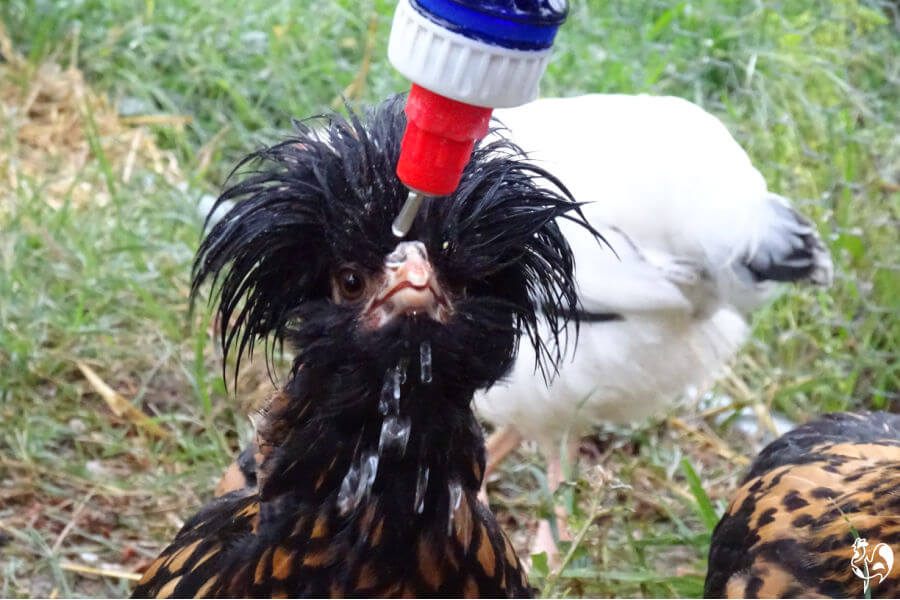 My Polish chick enjoying a hydrating drink.
My Polish chick enjoying a hydrating drink.There is some evidence that water temperature means chickens are more or less likely to drink, so make sure that the water you offer falls within those limits.
Step 9: ensure your flock has constant access to water.
- You may see complicated calculations on some websites about how much each chicken needs to drink per day. They are irrelevant. Make sure your chickens have constant, free access to water during daylight hours. They will take what they need.
- Once roosted, chickens do not either drink or eat, so there is no need to keep the water supply inside your coop. In fact, it can lead to damp conditions which give rise to all manner of illnesses.
- Studies(e.g. 4) have found that the ideal water temperature to encourage chickens to drink is around 13° C (55° F) – just below the chicken's normal body temperature.
For more detailed information about how to make sure your chickens are getting the best supply of water, see this article.
Why boredom is a factor – and what to do about it.
Chickens are pretty self-sufficient. Given a safe place to live and roost, food that meets their nutritional needs, plenty of water and somewhere to scratch around and take a dust bath, they're generally happy.
But there are times when a chicken should, or chooses to, be contained. Extreme winter weather, times when Avian Influenza (bird flu) is rife, when predators are on the prowl...
A contained chicken will soon become a bored chicken. And boredom in chickens, as well as in humans, leads to all kinds of behavioural issues – including egg eating.
Step 10: keep your chickens occupied!
- Make sure you have enough space per bird both within the coop, particularly on the roosts, and outside it.
- If possible – and there are risks involved – allow your flock to free range. It not only beats boredom, but allows them to forage for healthy plants, weeds and bugs!
- Give them things to peck at that aren't eggs. Healthy treats, seed blocks and hanging veggies are all a welcome distraction.
- This is how my flock spends some of their time. It's easy and inexpensive to set up, and allows for hours of fun!
For more detailed information about beating boredom, see this article.
Is it possible to cure egg eating chickens?
Once an egg-eating problem starts, it's incredibly difficult to stop. Leaving the behaviour to continue is not an option because sooner or later, the whole flock will be chomping down on their own eggs and you'll have none.
There's no sure way to "cure" it, but these options are worth trying.
1. Isolate an egg-eating chicken.
Chickens are sociable creatures, and isolating can often stop an unwanted behaviour. At least if s/he's not within reach of the rest, there will be less opportunity to eat other people's eggs!
This option does, of course, rely on being able to identify the offending chicken, which isn't always possible.
If you can find the right bird, always make sure you isolate within sight and sound of the rest of the flock, otherwise it will be hard to re-integrate her. Something like a dog crate placed within the coop (if your coop's big enough) works well.
For other isolation options, see this page.
2. Plant "dummy" eggs in the nest box.
Some people swear by this option, for others it has no effect at all. It's a simple concept: place eggs in the nest box which are not real.
The idea is that when a chicken goes to eat the egg, they'll find they can't, and will stop trying.
Something like these wooden eggs is inexpensive and worth a go, and ceramic is also a popular choice, though they can break more easily.
If you use wooden eggs and discover they've been chewed, it's likely you have a rat problem, and rats might therefore be the real egg-eating culprits...
See this article for everything there is to know about getting rid of rats from the chicken coop.
3. Use soap and mustard...
Some say this works a treat, others that it is an ineffective "old wives' tale". It's based on a chicken's aversion to eating certain substances.
For many years it was thought that chickens had very few tastebuds, but research has recently discovered that, although they don't have anything like the number that mammals do, they have more than was previously recognised(5).
Additionally, the same study found that chickens have a strong aversion to eating bitter tasting foods. So the theory behind this potential solution is that, if a chicken breaks an egg only to discover it has a bitter taste, s/he will avoid it – hopefully for long enough to break the habit.
How to do it: make a small hole in one end of an egg and empty out the contents. Refill with one of the following, plug the hole and place back in the nest box:
- Mustard
- Hot sauce
- Chilli powder mixed with vegetable oil
- Vinegar
- Liquid soap.
Will it work? Only your chickens know the answer to that! If you're desperate for a solution and nothing else has been successful, it's certainly worth trying.
4. Do not do this... de-beaking.
Taking off the point of a chicken's beak is done commercially to prevent chickens from pecking each other, or their eggs.
Just don't do it.
It's painful for the bird, it's inhumane and it doesn't necessarily work. One of my ex-caged rescue hens was a great believer in eating as many eggs as she could lay her de-beaked beak on. She simply battered them until they broke.
Related pages you may find useful.
Sources.
A lot of "facts" you'll find on the internet are often people's individual views, based on inaccurate information repeated from poor quality sources.
The information I provide in this article and others is based not just on my own experience, but on evidenced facts from scientific, peer-reviewed research and books from highly respected and experienced poultry keepers such as Gail Damerow.
Some of the trusted sources I have used in this article are these.
1. Department for the Environment, Food and Rural Affairs (DEFRA): Code of practice for the welfare of laying hens and pullets. Pub UK government, August, 2018.
2. RSPCA: Welfare standards for laying hens. Pub. Royal Society for the Prevention of Cruelty to Animals, 2017.
3. European Union: Higher welfare systems for laying hens. Pub. EU Commission, via Compassion in World Farming, 2018.
4. Carter, T. A., and Sneed, R. E.: Drinking water quality for poultry. Pub. North Carolina State University, Department of Poultry Science, 1987.
5. Hong-Xiang Liu et al: An Update on the Sense of Taste in Chickens. Pub. Journal of Nutrition and Food Sciences, 2018.
6. Clauer, P: Prevention of Egg Eating in Chickens. Pub. Pennsylvania State University, 2016.
7. Causes for hens eating ther eggs. Pub. Mississipi State University, 2022.
- Home
- Challenges
- Egg eating
